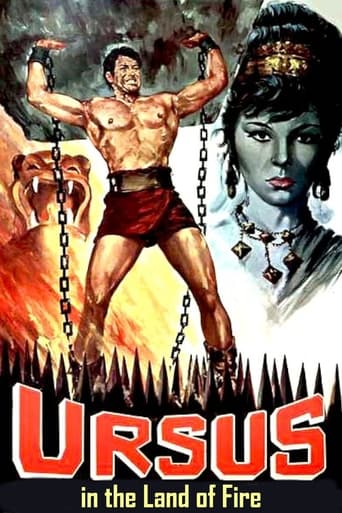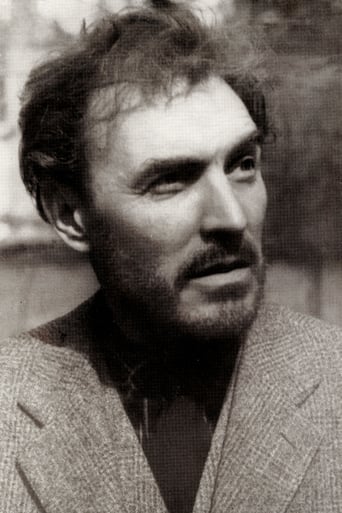Cleveronix
A different way of telling a story
WillSushyMedia
This movie was so-so. It had it's moments, but wasn't the greatest.
Celia
A great movie, one of the best of this year. There was a bit of confusion at one point in the plot, but nothing serious.
Isbel
A terrific literary drama and character piece that shows how the process of creating art can be seen differently by those doing it and those looking at it from the outside.
Cristi_Ciopron
A fairy-tale flavored adventure movie with Ed Fury and A. Micantoni. What I believe to be the worthiest of mention are Hamilan the usurper's role and the spooky score. Also the tournament, and then Ursus enslaved.Micantoni, who plays the usurper, reminded me of Wallach, and made the best of his scenes; he has one of the couple of the best one-liners of the movie: his comes after he has killed his wife, who refused divorcing him. The 2nd belongs to Ursus, when he thanks one of the guards for his advice.The setup reminded me of the political westerns that were being made in the same decade, with the social awareness: here, a village of shepherds being attacked by the soldiers from across a lake, in a fight for resources, then a military coup, almost like one of those very fashionable for a time political westerns made in Europe …; but these are also from the fairy tales. Anyway, the story is well handled (though Ursus' idea of avenging the peaceful shepherds is to defy single-handed and challenge the new king, which promptly results in his arrest; the fact being that Ursus doesn't have a plan for avenging his people, but entrusts himself to a whirlpool of events, his single plan might of been of course to defeat the king in the arena, supposing that the sovereign would of taken up the challenge). The cast has a lot of clergymen, more pious and cautious than just, and a prophet; anyway, the high priest proves of some help to the insurgents.The landscape is mainly dreadful, but I think I recognized the waterfalls from another s & s movie.By the early '60s, the European kids seem to have got a peculiar education by movies like this, which is a fact perhaps less analyzed sociologically.
unbrokenmetal
The evil Hamilkar (Adriano Micantoni) wants to dethrone old king Lotar (Nando Tamberlani) and become king himself. But besides King Lotar, there are three other people blocking his way to the throne: the high priest who accuses him of sacrilege and murder, the popular hero Ursus (Ed Fury) and the king's daughter, princess Diana (Luciana Gilli). Hamilkar needs another mind's help (namely his wife's) to come up with a plan how to kill them all! Especially in the case of our hero Ursus, he'll find that very hard, though.It's an OK genre movie, all the usual trademarks, but nothing outstanding. Good studio sets, but the outdoor scenes look cheap. The volcano is shoddy, and the lake is supposed to be the border between two countries, so they should not have picked such a small pond... The most memorable action scene is the tournament, when 5 opponents try and push Ursus into a spiked pit.
doug1717
I found this film in a collection of old films on eBay. I certainly wasn't expecting "Spartacus" , just some matinée fun like the old Sinbad features. Ursus is the sort of predictable film you could add your own smart-alec dialog to and still have fun. Well the film doesn't have a cast of thousands, but it really isn't that bad. The film revolved around Ed Fury's pre-steroid abuse hulking frame and his diminutive little brother. They end up on a quest to help a princess Ursus had a romantic history with. During the first battle scene, Ursis kicks butt bare handed until he reaches into a cart and finds a conveniently placed 5 foot long club replete with spikes that looks like it came from the Flintstones. The bad guy looks amazingly like "Lost!" actor Terry O'Quinn, and is reminiscent of Ming The Merciless. The women are all buxom and tightly clad, and there are Herculean challenges and evil plots for Ursus to surmount. I always wondered why these sort of films gave these strong men feats of strength to prove their innocence. In Ursus's case, he might have defeated an elephant, but I bet a math test would have laid him low.
dinky-4
Having heard good things about this sword-and-sandal movie, I found myself a tad disappointed with some of its aspects, but in general, this is superior to most of its competition and "Hercules" fans will find it well worth a look. Of particular note are several of the imaginative and impressive indoor sets which are a clear cut above the plywood-columns sort of decorating one often sees in this genre. Of course, any "Hercules" movie must largely be judged on the appearance and appeal and talents of its main actor, and here we're fortunate to have Ed Fury, who not only looks good with his shirt off but who has some personal flair as well. He plays the part with an agreeable touch that's a welcome break from the "grimly determined muscleman" school of acting. Another way of judging these movies lies in the quality of the tortures which are inflicted on the hero. Here, we have two good ones. In the first, Fury is chained to one of those wooden poles which protrudes from a circular grist-mill. "Encouraged" by a burly overseer who lashes him across his bare back, Fury must walk around in a circle, pushing that pole and turning that grist-mill. (And boy, is this a big grist-mill!) Unlike other such sequences, such as that involving Victor Mature in "Samson and Delilah," this horizontal pole is not at waist level but rather positioned above Fury's head so that his chained arms are extended upward from his body. This seems to make the ordeal even more strenuous and painful and effectively showcases Fury's physique. In the second torture, he's forced to stand on a dungeon floor amid a number of sharp metal spikes which protrude upward. He's also forced to hold above his head an enormous flat stone. Eventually his arms will weaken and the weight of that stone, pressing inexorably downward, will impale him on those spikes just before it crushes him. The appeal of this torture is that it turns the hero's chief asset -- his strength -- against him. The longer he's able to hold up that stone, the more he prolongs his agony. And in the process, of course, the more entertainment he provides for his captors -- and for the movie audience as well!


